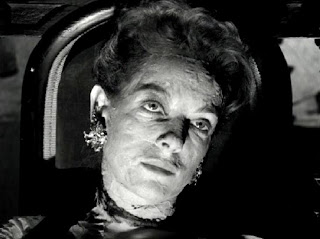Directed by:
Peter B. Good
Most people who've seen their fair share of shot-on-video, direct-to-video horror cheapies from the 80s probably cringe at the thought of sitting through another. That goes double for anyone who's seen any that were released on the Tapeworm label, whose acquisitions were about as appealing as their company name. The acting in these things is almost always terrible and the writing and direction usually even worse. Couple that with extremely low production values and the sheer technical incompetence generally on display, and it's no wonder only a tiny niche audience who actually find enjoyment in these things exists. So I am pleased to report that Fatal Exposure managed to rise above the extremely low expectations I had initially set for it. Amongst all of the other shot-on-video efforts from this time, this perhaps comes closest to cutting it as an actual movie. It's reasonably well-made, has plenty of gore and nudity, a ridiculous, though very entertaining, storyline, some effective black comedy and lead actors with some charisma and talent. In the slasher subgenre, regardless of budget, this is also an above par offering.
A young couple (including ELVES star Julie Austin) are messing around in a car out in woods when they're attacked by a panty-hose-over-the-face psycho armed with an ice pick. The psycho responsible is Jack T. Rippington (Blake Bahner); the handsome and charming great grandson of infamous serial killer Jack the Ripper. Jack has just recently moved into one of those large old plantation homes in the small town of Prairieville, Alabama. His first visitors are Maggie Hopkins (Renee Cline) and her husband Jeff (Greg Wise), who pop in to welcome the newcomer to worship services at the town's church. Jack is working on a magazine article called "The Art of Death" and his attempts to photograph death scenes using mannequins just aren't working so he decides to draft his new visitors as models. Jeff is placed in a rack and gets his head lopped off, while his wife is tied to a chair and injected with acid. The death pictures end up capturing the realism Jack has been striving for because they are real. He then goes about recruiting other oblivious models to pose for him.
Aside from working on his project and killing various people, Jack is interested in meeting "the perfect woman" who will conceive a child to help carry on the legendary Rippington name. He drinks fresh human blood to stay sexually potent and asks each woman he runs across and is interested in three questions. 1. "Have there been times in your life when you've been obsessed with death and dying?" 2. "What do you think about when you hear the word blood?" and 3. "Have you ever thought about killing someone?" So far, none of the women have answered to his satisfaction. Jack disposes of the bodies in a crypt in an old cemetery where he doesn't think anyone will look and meets Erica (Ena Henderson), a pretty young woman with some edge to her, there. Not only does she have an interest in death and ghosts, but she's also kind of turned on by blood. Ding ding. We have a winner.
Jack begins dating Erica and even has her go into the big city to modeling agencies to help lure professional models back to his home. Of course the naive small town girl has no clue what Jack is up to or what she's doing and doesn't even realize he's already dismembered her suspicious best friend Gretchen (Joy Ovington) with an electric saw. Erica finds out she's pregnant. Jack's elated, but when Erica discovers what he's doing and tries to run off, he chokes her out and locks her up in his basement. He plans on keeping her prisoner there for seven months until she gives birth.
Aside from what's already been mentioned, there's an electrocution, a head blown off with a shotgun, a neck slashing, a stabbing with a shard of glass and other bloody moments. The best bits are a few acid meltdowns, including one where Jack spikes the dumb hick sheriff's (Marc Griggs) drink during a beer chugging competition. Pretty good makeup effects and a generous helping of female nudity helps things along. Bahner gives a competent performance in the lead role and it's no surprise he went on to do other things, though primarily in the direct-to-video arena. His character also narrates and even makes some asides directly to the camera. Lead actress Henderson is adorable and a decent little actress to boot so I'm surprised she only did one other film.
The director's name sounds like a pseudonym but it's not; he was born Peter Benson Good. His other credits include mostly camerwork, including shooting the classic exploitation flick JOHNNY FIRECLOUD (1975) and some of the FACES OF DEATH sequels.
★★1/2
















































